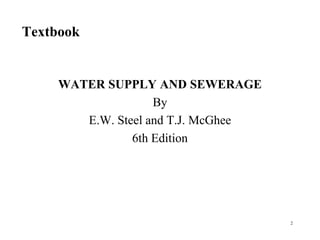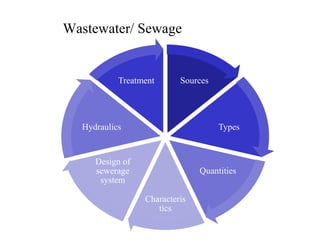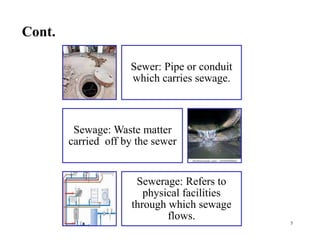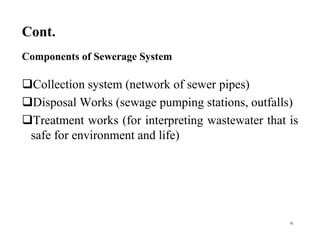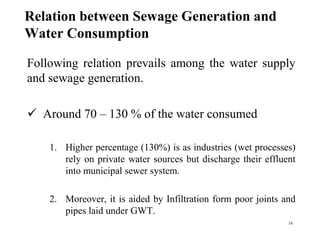Sources of wastewater
- 1. Wastewater/ Sewage Resource Person Engr. Sidra Rashid sidradar9@gmail.com
- 2. Textbook WATER SUPPLY AND SEWERAGE By E.W. Steel and T.J. McGhee 6th Edition 2
- 4. Introduction Wastewater, a combination of liquid and water- transported wastes along with any groundwater infiltration, surface water and stormwater inflow that may enter the sewer system. Waste may come from homes, commercial buildings, industrial facilities, and institutions 4
- 5. Cont. 5 Sewer: Pipe or conduit which carries sewage. Sewage: Waste matter carried off by the sewer Sewerage: Refers to physical facilities through which sewage flows.
- 6. Cont. Collection system (network of sewer pipes) Disposal Works (sewage pumping stations, outfalls) Treatment works (for interpreting wastewater that is safe for environment and life) 6 Components of Sewerage System
- 7. Sources of Wastewater 7 1.Domestic Sewage • Wastewater produced due to human activities in households • i.e., residential buildings, offices, hotels and institutions etc. Industrial Wastewater • It includes the liquid discharges from industrial processes. Storm Sewage • It include surface run off generated by rainfall and the street wash.
- 8. Factors Affecting Sewage Generation Size of City Population Characteristics Industries and Commerce Climatic Conditions Metering 8
- 9. Types of Sewers 9 1. House Sewer A pipe conveying wastewater from an individual structure to a common sewer or some other point of disposal. 2. Lateral Sewer A common sewer with no tributary flow except from house sewers. 3. Submain Sewer It collects flow from one or more laterals or house sewers.
- 10. Cont. 10 4. Main/ Trunk Sewer It collects flow from several submains as well as lateral and house sewers 5. Force Main A pressurized sewer lines which convey sewage from a pumping station to another main or to a point of treatment or disposal. 6. Outfall Sewer It receives discharge from all collecting system and convey it to the point of final disposal (e.g., a waterbody etc.)
- 11. Cont. 11
- 12. Types of Sewer Systems 12 1. Separate System If storm sewage is carried separately from domestic and industrial wastewaters 2. Combined System A system of sewers that carry both sanitary as well as storm sewage. 3. Partially Combined System If some portion of storm or surface run off is allowed to be carried along with sanitary sewage NOTE: In urban areas of developing countries, mostly partially combined system is used.
- 13. Cont. Separate sewers are preferred when There is an immediate need for collection of sanitary sewage but not for storm sewage When sanitary sewage needs treatment but storm sewage does not Costly construction and requires extra maintenance 13
- 14. Cont. Combined sewers are preferred when Combined sewage can be disposed off without treatment Both sanitary and storm sewage need treatment Streets are narrow and two separate sewers cannot be laid Preferred in present construction except previously constructed old combined sewers But in Pakistan combined sewers are preferred as sewage is disposed of in Canals, rivers and for 14
- 15. Sewage Flow / Quantity Domestic and industrial sewage is derived from water supply, so it has a relationship with amount of water consumption. Generally About 70-90% of the total water supplied to a community becomes wastewater Illicit drains and water use from privately owned source may produce quantities of sewage larger than public water withdrawals. 15
- 16. Relation between Sewage Generation and Water Consumption Following relation prevails among the water supply and sewage generation. Around 70 – 130 % of the water consumed 1. Higher percentage (130%) is as industries (wet processes) rely on private water sources but discharge their effluent into municipal sewer system. 2. Moreover, it is aided by Infiltration form poor joints and pipes laid under GWT. 16
- 17. Cont. Variations in sewage flow presents no fixed relation between sewage production and water supply. However generally it ranges from 70 – 90 % of the water consumption. After taking into consideration the rate of infiltration, the average rate of sewage flow equals the average rate of water consumption. 17
- 18. Cont. Infiltration is non-existent in dry weather but increases during rainy seasons. WASA considers following infiltration rates 18 Infiltration The water which enters the sewers form ground through poor joints, cracked pipes, and the walls of the manholes. Inflow The water which enters the sewers from surface through perforated manhole covers, roof drains connected to the sewers, and drains from the flooded cellar etc. Sewer Dia. (mm) 225 – 600 5 % of Average Sewage flow= Infiltration Sewer Dia. (mm) >600 10 % of Average Sewage flow= Infiltration
- 19. Cont. Amount of Storm Sewage Rainfall is the primary source of storm flow. Estimation of flow is the first step to design the Storm sewer. Rational Method is widely used Based on rainfall data. Most widely used formula for urban areas 19
Editor's Notes
- Physical facilities may include pipes, lift station, collection, treatment and disposal facilities
- Factor affecting water consumption are responsible for the rate of sewage generation. Small/Large, Level of development Economic Status, Norms of society, Habits Extreme hot/ cold weather Pricing
- Domestic and industrial sewage is derived from water Supply Associated with water supply to the city/community.
- Domestic and industrial sewage is derived from water Supply Associated with water supply to the city/community.
- Water and Sanitation Agency (WASA)

